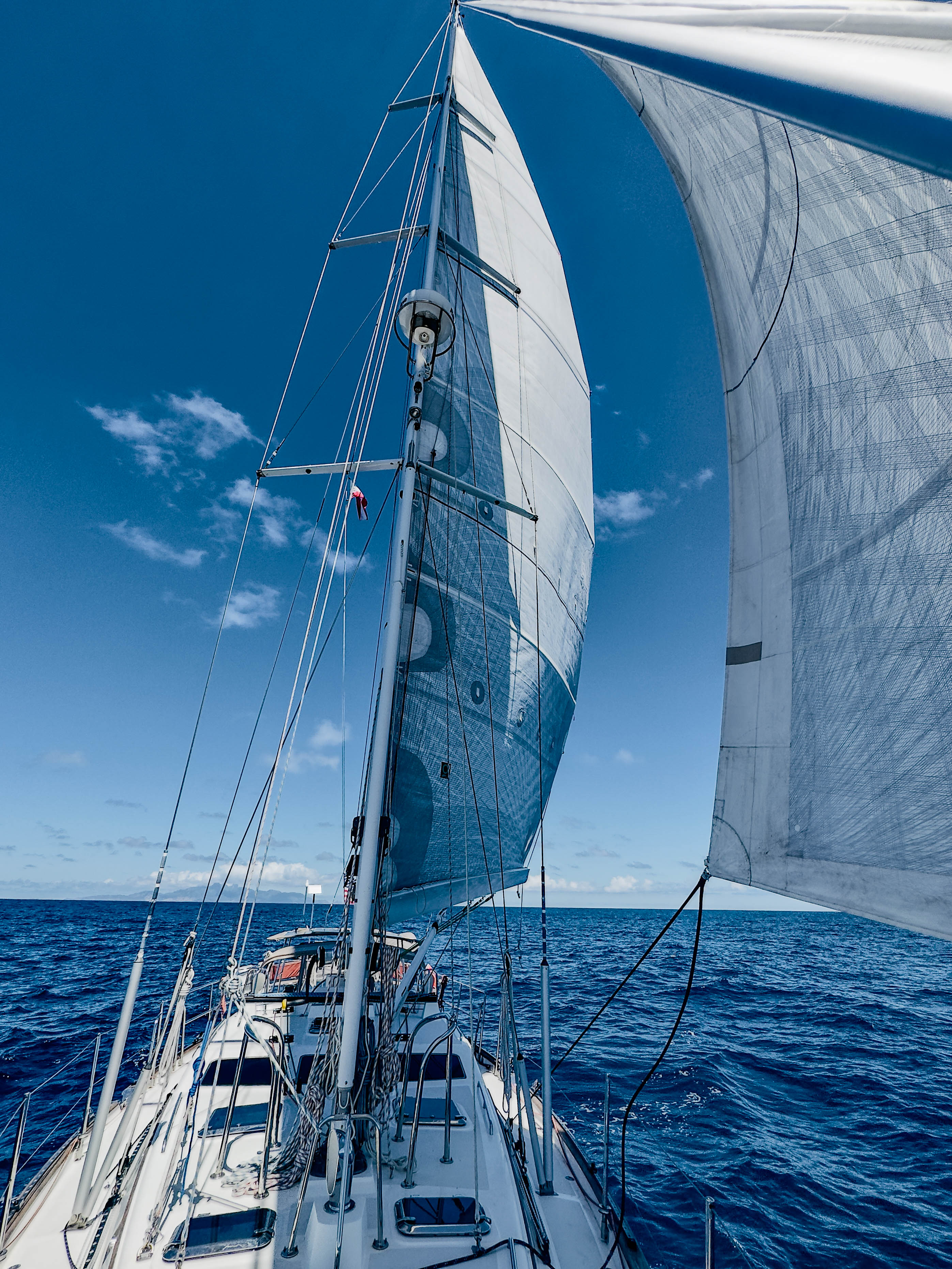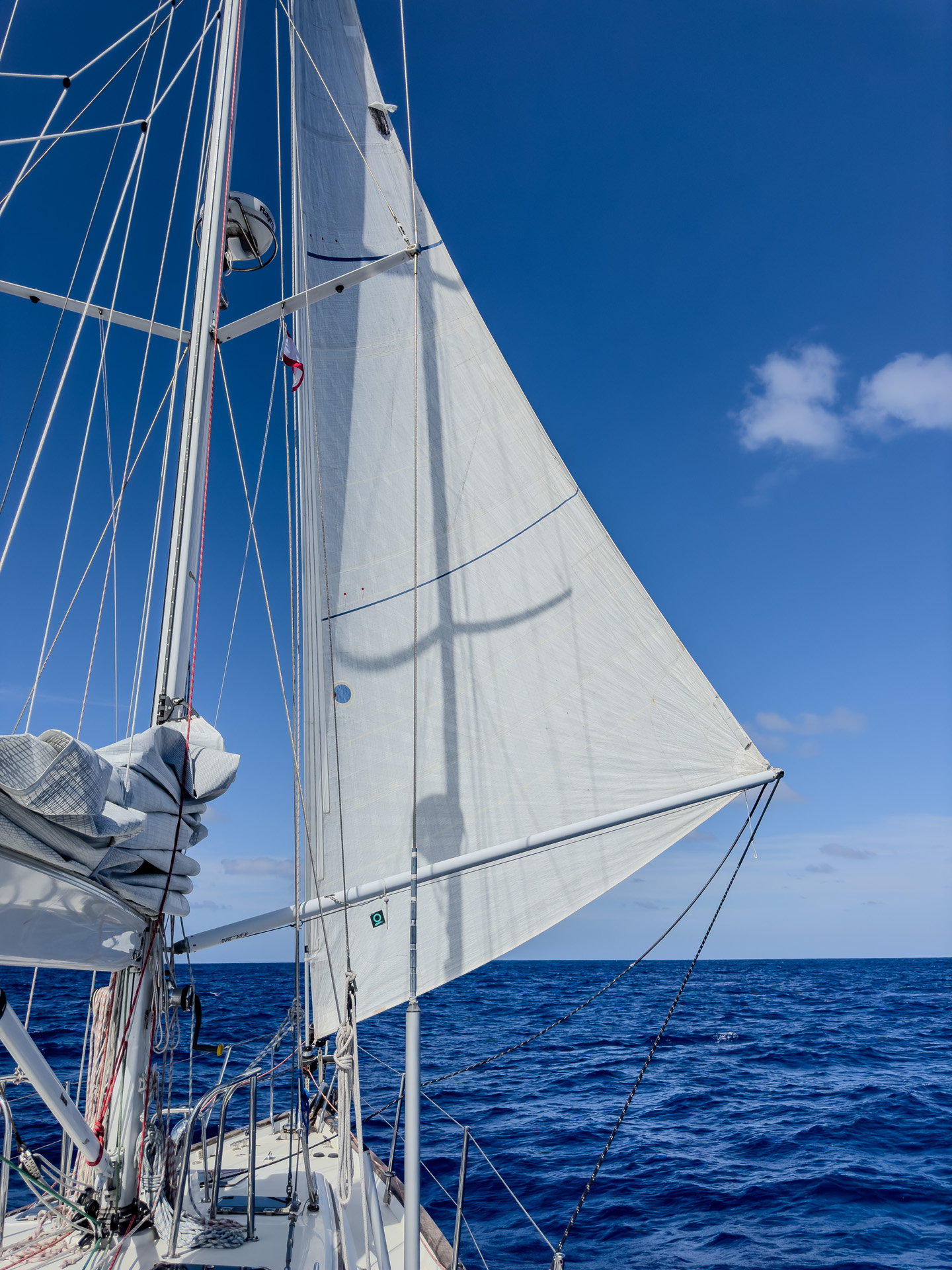In an earlier article, “9 Powerful Advantages of a Solent Rig for a Voyaging Sailboat,” we looked at why the Solent rig is an ideal choice for bluewater cruising boats. This follow-up covers the “how”: how to use it and get the most from it in real offshore conditions.
The Practical Idea Behind the Solent Rig
Most modern cruising sloops carry a single roller furler on the headstay. To get a wide wind range from that one sail, the common approach is to fit a large genoa—typically 130–155%—and, as the wind builds, “reef” it by partially furling. It works in theory, but the result is rarely efficient. A partially rolled genoa loses its designed shape, the draft moves forward, and performance and balance both suffer.
As the wind continues to rise, the proper next step would be to switch to a smaller working jib. But that’s easier said than done. With only one stay, the genoa must first be completely unfurled, dropped to the deck, secured, and then the jib has to be fed into the same foil track—all while the boat is pitching in open water. In practice, it’s such a cumbersome process that most sailors simply tolerate the poorly shaped, partially furled genoa rather than attempt a full sail change.
The Solent rig solves this elegantly. By adding a second headstay, mounted just aft of the main forestay, you gain a dedicated place for a smaller, heavier-weather sail without touching the genoa. When the breeze begins to build, you simply furl the headsail on the outer stay and set the working jib on the inner stay—no sail changes on deck, no wrestling heavy canvas, and no compromises in sail shape.
Whether the inner stay is stowable—deployed only when needed and carrying a hanked-on sail—or permanent with its own furler, the concept is the same: clean, controlled transitions between light-air power and heavy-weather efficiency, managed safely from the cockpit.
Two Main Types of Solent Stays
Stowable Solent Stay
A stowable Solent stay typically uses a highfield lever or turnbuckle at its base to achieve full tension when deployed.
Sail type: Typically carries a hanked-on #3 jib—a dedicated heavy-weather or “Solent” jib. A separate storm jib (#4 or smaller) can also be set on the same stay when conditions demand.
Use case: Heavy-weather or ocean passages where the sail can be hoisted before conditions deteriorate.
Handling: When deployed, the stay should be fully tensioned to minimize sag; when stowed, it must be kept well clear of the foretriangle so it won’t interfere with a Code 0 or genoa on the headstay.
This system is simple and mechanically robust—ideal for sailors who prefer traditional hanked sails and minimal gear forward.
Permanent Solent Stay
This configuration keeps the inner stay permanently rigged, often with its own roller furler—the arrangement we use aboard Wanderlust.
Sail type: Usually a #3 working jib, heavy-weather jib, or storm jib.
Advantage: You can shift between the forward headsail and the Solent jib entirely from the cockpit, never needing to go forward.
Tensioning: Because it’s used in heavier air, the Solent stay should carry full tension to keep it straight under load. The outer forestay (with the Code 0 or genoa) carries slightly less tension, allowing a bit of sag to power up that sail in lighter air.
It’s a refined setup for modern voyaging yachts—clean, reliable, and easy to manage short-handed.

Managing Headsails Underway
The Solent rig really comes into its own when you learn to predict changing conditions, expect sail changes and make them before the wind forces your hand.
Switching Sails
As the wind builds, changing headsails on a Solent rig is simple when both sails are on furlers. You furl the headsail on the outer stay and deploy the Solent jib on the inner stay, all from the cockpit. The process is quick, controlled, and keeps the boat balanced as conditions evolve. When the wind eases again, the sequence is reversed: furl the Solent jib and redeploy the Code 0 or genoa for more power.
If the Solent sail is hanked on instead of roller-furled, some foredeck work is required. The sail is staged by hanking it onto the stay and lashing it down in its bag at the base of the Solent stay—typically a #3 working jib or, in heavier weather, a storm jib. When it’s time to set it, someone must go forward to unlash and hoist the sail before conditions make the deck unsafe. Likewise, when the sail is doused, it must be bagged and lashed down again—or removed if a different sail is to be used.
On Wanderlust, we addressed this by adding a third stay—an inner forestay about where a traditional staysail stay would be. It stays stowed by the mast and is deployed only when we expect conditions that call for a storm jib. With that stay rigged, tacking or gybing the Solent jib becomes more difficult (though still possible), so we typically furl it before maneuvering—just as we do with the Code 0.
Tacking and Gybing the Solent Jib
Tacking or gybing is straightforward. The smaller, high-cut jib passes cleanly through the foretriangle whether sailing upwind or downwind, and its inboard sheeting angle delivers excellent pointing ability.
Tacking and Gybing the Code 0 or Genoa
Because the space between the headstay and Solent stay is too narrow for the large sail to pass through easily, the sail should be furled before any tack or gybe, then redeployed on the new tack. This prevents damage to the sail and fouling of sheets.
In practice, the rhythm becomes second nature: furl, maneuver, deploy. The result is smooth and predictable, with no foredeck drama—one of the Solent rig’s biggest advantages offshore.
Practical Sail Combinations and Trim
No two passages—or boats—behave the same way, but certain combinations consistently work aboard Wanderlust. The Solent rig makes it possible to carry a balanced sail plan across a wide range of conditions without ever leaving the cockpit. The key is matching sails to both the point of sail and the character of the breeze—steady, gusty, or shifty—and using the right sheet leads for each.
Upwind
Close-hauled, it’s always main and jib. The Solent jib sheets to the inboard track for a tight sheeting angle and good pointing ability.
From a close reach through beam reach, the Code 0 comes into play in lighter conditions—up to about 12–15 knots of true wind if the air is steady. I switch from the Code 0 to the jib when Wanderlust develops more heel or weather helm than can be balanced with mainsail trim. The transition is simple: furl the Code 0, unfurl the jib, and keep sailing without a pause.
As the wind builds into the high teens, a single-reefed main and jib give a comfortable, balanced setup. Beyond 18–22 knots, a double-reefed main with the jib keeps the helm light and the autopilot happy.
Above 25–28 knots, I roll a small reef into the jib; above 30, it’s a double-reefed jib. Past 35 knots, the storm jib and trysail are ready, though I’ve never had to set them.
Beam Reach to Broad Reach
As the boat bears away, trim matters more than sail choice. The jib moves to the outboard track once the apparent wind is abaft the beam, opening the slot and easing loads. Around 15 knots of true wind, I usually put a reef in the main—not to depower, but to make life easier for the autopilot in a rolling sea.
The Code 0 carries well to about 16–20 knots true and is still efficient out to roughly 135° apparent before it starts collapsing in the main’s shadow. Around 20–22 knots, I furl the Code 0 and switch to the jib, sheeted outboard; at the same time, the second reef goes into the main. Even in 25 knots with gusts to the low 30s, that setup stays comfortable and balanced without reefing the jib further.

Deep Off the Wind
To sail deeper than 135° apparent, the Code 0 begins to blanket, so I pole out the jib to windward and sail wing-and-wing.
In steady tradewind conditions, dousing the main and running a poled-out jib to windward with the Code 0 to leeward gives twin headsails that act much like a spinnaker—stable, simple, and fast.
In very light air (3–5 knots) and sloppy seas where the main slats, I’ll sometimes sail with just a poled-out jib to keep the boat moving, even if we’re only making a few knots. When the breeze steadies but is still light, the Code 0 alone will move Wanderlust at five knots.
There have also been a few memorable runs in 20–25 knots of gusty following wind where I’ve carried only the Code 0 downwind—and Wanderlust has held nine to eleven knots, balanced and composed.
These combinations aren’t rigid rules—they’re a framework built around balance, helm feel, and sea state. Every boat has its own rhythm, and the real skill lies in sensing when to shift gears before the rig or autopilot tells you it’s time. The Solent setup just makes those changes simpler and safer, letting you keep Wanderlust—or any well-found cruiser—sailing efficiently across the full range of wind and sea without ever feeling rushed by them.
Trim, Balance, and Matching Sails to Conditions
The real advantage of a Solent rig is that it makes it easy to carry the right sail for the conditions. Instead of relying on one oversized genoa to cover the entire wind range, you can shift smoothly between sails designed for their own purpose and wind strength.
When the breeze builds, furl the genoa or Code 0 and set the working jib on the inner stay. If it continues to rise, the storm jib and trysail are ready where they belong—no foredeck work, no drama.
A well-balanced Solent rig keeps the boat driving efficiently and under control. The result is a rig that adapts cleanly to changing conditions, stays efficient across a wide wind range, and lets you manage power without compromise or stress.
The essence is progressive adjustment: steady, predictable, and always under control. That’s what makes the Solent rig such a forgiving and confidence-building configuration offshore.
Why It Matters
The Solent rig isn’t about extra gear—it’s about options. Options to change sails safely, to keep moving in light air, and to carry on in heavy weather without leaving the cockpit.
Once you’ve lived with it offshore, you start to appreciate what it really delivers: control, comfort, and confidence when the miles stretch out ahead.
